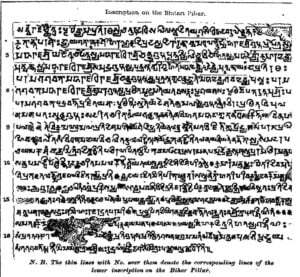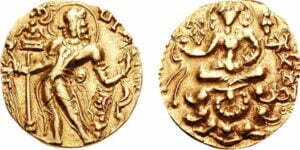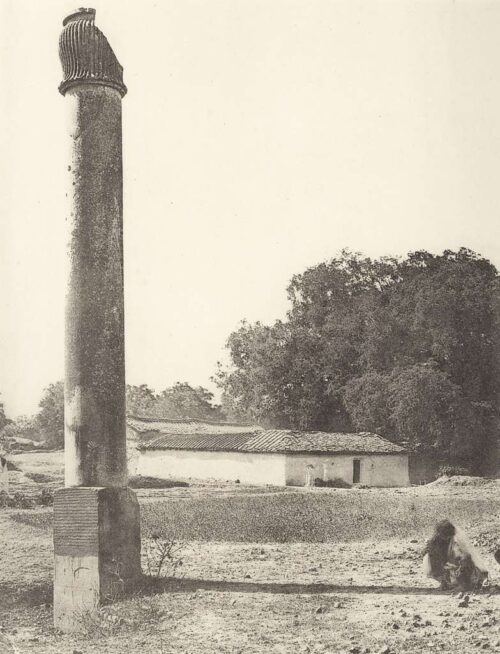In ancient Indian history, The Gupta period shines as the golden era, and Skandagupta, one of the Gupta rulers, is remembered as the savior of India. Over Skandagupta’s 12-year reign, he not only protected India’s rich culture but also defended the country from outside attacks. The Bhitari Pillar Inscription is such an important historical record that tells us about the Guptas, especially Skandagupta. It plays a great role in understanding the lineage of the Guptas. It mentions the great achievements of Skandagupta such as defeating the Pushyamitras and the Hunas. Besides these, the inscription also tells about Skandagupta’s military prowess.
Location and Discovery:
The Bhitari Pillar Inscription was found in Village Bhitari in Uttar Pradesh. The Village Bhitari is situated about 32 Km. from Ghazipur district near Saidpur town. This inscription belongs to the 8th Gupta Emperor, Skandagupta’s reign (around 455-467 CE).
A Brief Description of Bhitari Pillar Inscription:

The Bhitari Pillar inscription of Skandagupta consists of 19 lines. It was written in the Sanskrit language. The inscription begins with the genealogy of Skandagupta’s ancestors and highlights their great attainments. Then there is a self-presentation of Skandagupta in the next few lines. After that, the inscription provides a lot of information about Skandagupta’s triumphant journey. It tells about the defeat of Pushyamitras, the Military Prowesses of Skandagupta, and the defeat of Hunas. Then the last few lines of the inscription showcase Skandagupta’s dedication to the religious merit of his father.
You can also read our other inscription related article.
Some facts Mentioned in the Bhitari Pillar Inscription:
All the lines of the inscription are translated by various scholars. Here, we are going to learn some of those mentioned facts in a simpler way.
The inscription opens with praise for Samudragupta, by highlighting his remarkable qualities. Here, he is compared to gods like Dhananda, Varuna, Indra, and Antaka. He also restored the Ashvamedha sacrifice. These lines tell about Samudragupta’s strength and generosity. Besides these, it informs us that Samudragupta came from an illustrious lineage that included Gupta, Ghatotkacha, and Chandragupta (I). [L: 1-3]
This line is all about the Chandragupta (II). He was born to the Mahdadevi Dattadevi. The line conveys that Chandragupta (II) was a devoted worshipper of the divine one. He also gained acceptance from that divine entity. Chandragupta (II) was such a powerful ruler who had no equal opponent in strength. [L: 4]
The line praises Kumargupta’s strong religious beliefs, his royal status, and his connection with spirituality. It says that Kumargupta often meditated at the feet of the divine one, showing his devotion and humility. With this line the description of Skandagupta’s ancestors is complete. [L: 5]
Self Presentation of Skandagupta:-
From here, the remaining lines of this inscription are dedicated to Skandagupta. It describes Skandagupta as a ruler of great glory. This line compares his father’s feet to a wide-spreading waterlilies, and Skandagupta to a bee. It states that Skandagupta draws strength from his father’s legacy, much like a bee subsists on waterlilies. Skandagupta’s virtuous conduct enables those who perform good deeds. This section of the inscription marks Skandagupta as the most eminent hero in the lineage of the Guptas. Apart from these, he is portrayed as having a spotless soul and a deep understanding of musical keys. [L: 6]

In this part of the inscription, we come to know about Skandagupta’s various commendable attributes. According to the inscription, he achieved his goals by working hard every day and using good behavior, strength, and clever strategies. He learned how to manage resources effectively. He used this skill to defeat enemies who aimed to conquer his territory. [L: 8]
Defeat of the Pushyamitras:-
This line states one of the most important incidents of Skandagupta’s reign. That is the defeat of the Pushyamitras. The Pushyamitras had become very strong with a lot of military power and wealth. Skandagupta defeated them after a tough and lengthy battle. The inscription says that he had to spend a whole night on the bare ground. Thus, the line depicts his effort to restore his family’s fallen fortunes. [L: 10]
The next few lines of the inscription mainly praise the military prowess of Skandagupta. The 11th line mentions that his fame is ‘spotless’ and ‘inherent’. Also, it says that his fame has increased because of his outstanding military accomplishments, unmatched courage, and determination. The 12th line portrays Skandagupta as a powerful warrior who was able to restore the Guptas to their former glory. The 14th line says that he used his armies to rebuild his weakened lineage. With his own strength, he controlled vast lands. [L: 11-14]
Defeat of Hunas:-
This line talks about another significant incident of Skandagupta’s reign. That is the conflict with the Hunas. It shows how he engaged himself in the conflict and defeated the Hunas. It also says that Skandagdupta used arrows in this battle. Here, the powerful impact of the arrows is compared to the roaring of the river Ganga to emphasize their force and intensity. [L:15]
The inscription concludes by showcasing Skandagupta’s characteristic of devotion and reverence for his father’s legacy. He created an enduring image of the deity Sharngin. Then he placed the image in a village and dedicated the village to the deity, all to enhance his father’s religious merit. [L:17-19]
Significance of Bhitari Pillar Inscription:
Bhitari Pillar Inscription holds immense historical value. Besides, highlighting Skandagupta’s reign, achievements, and contributions, it mentions his benevolent acts also. Apart from these, the inscription provides insights into the Gupta lineage. So, through this inscription, we can gather a lot of knowledge about Skandagupta as well as his ancestors.
Every inscription serves as a bridge between then and now. Each provides various pieces of information about its era, enriching our historical understanding. The Bhitari Pillar Inscription is not an exception. It reflects various aspects of the Gupta Period, including historical events, cultural practices, socio-political factors, and many more. Thus, the Bhitari Pillar Inscription is a precious piece of India’s ancient history.


It’s awesome in support of me to have a site, which is good in support of my
experience. thaks admin https://www.Waste-Ndc.pro/community/profile/tressa79906983/
Thank You very much..💖 💖 💖
It’s awesome in support of me to have a site, which is good in support of my experience.
thanks admin https://www.Waste-Ndc.pro/community/profile/tressa79906983/